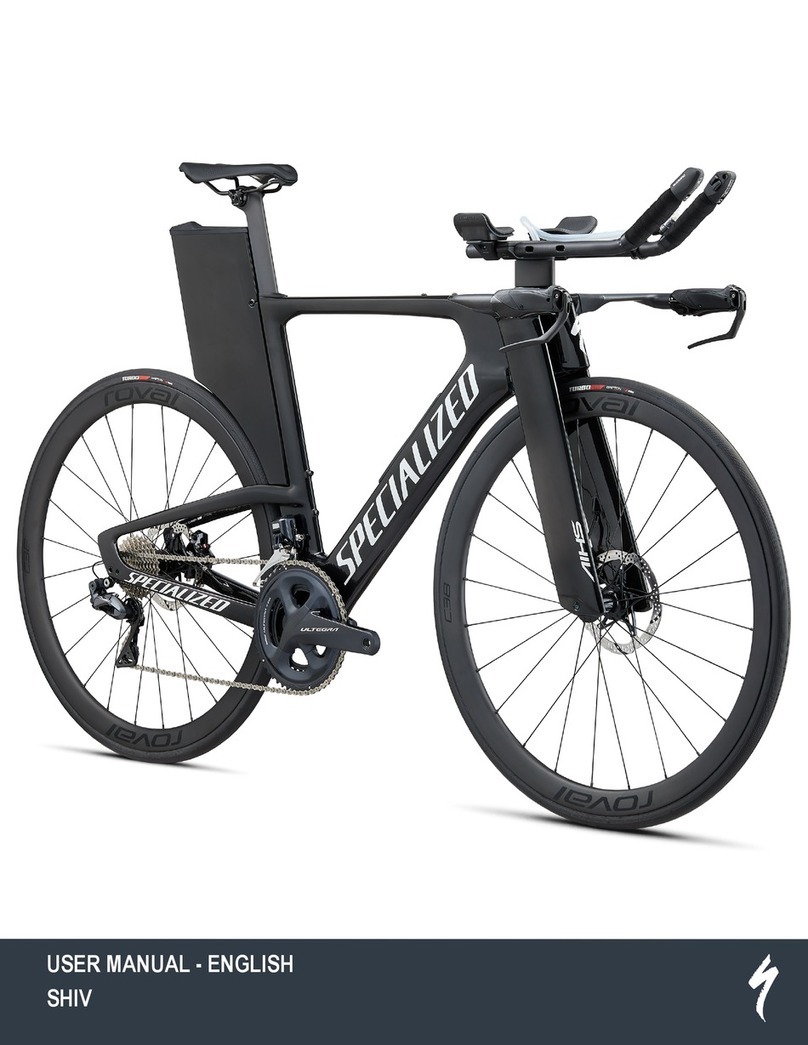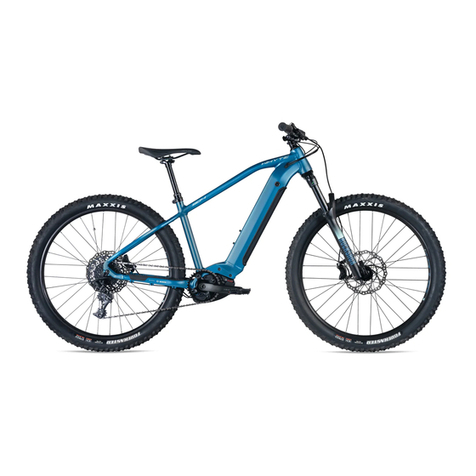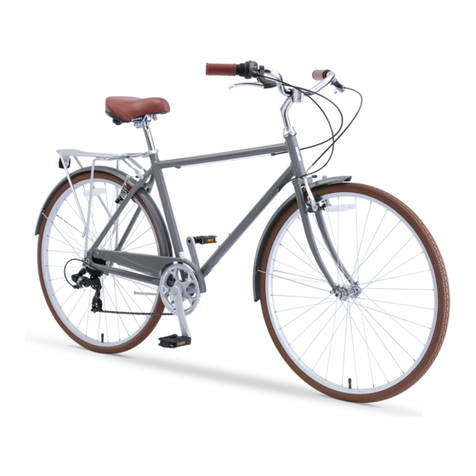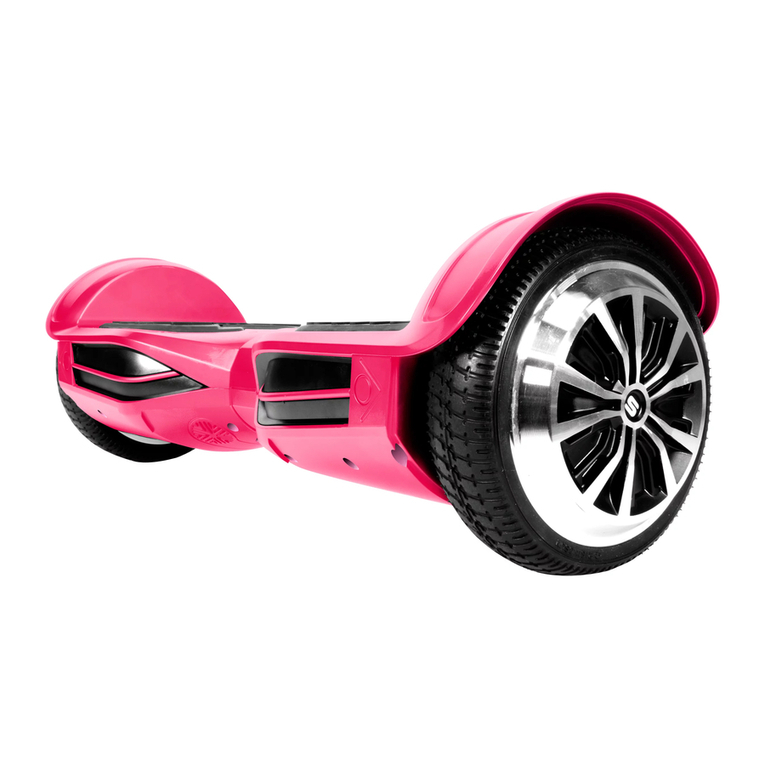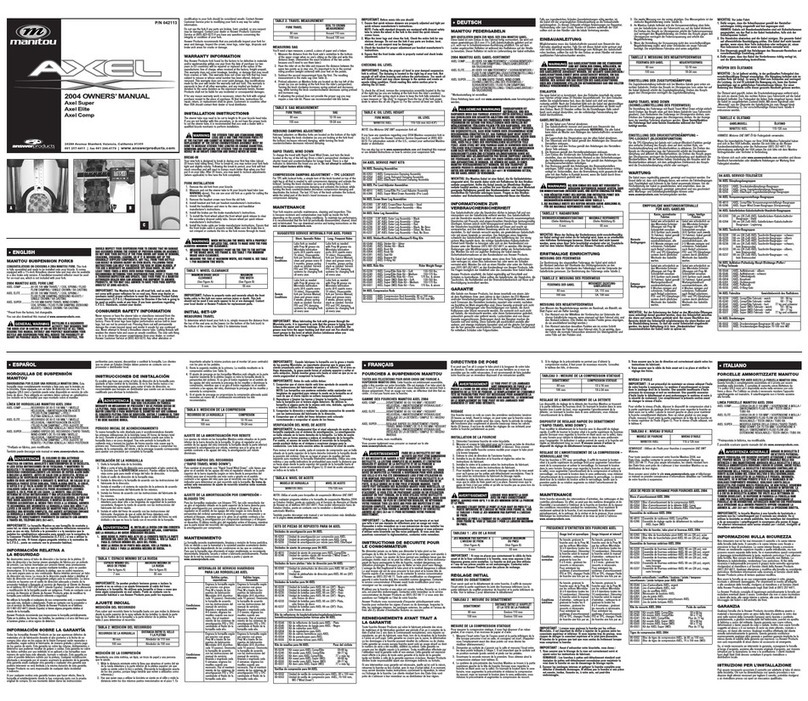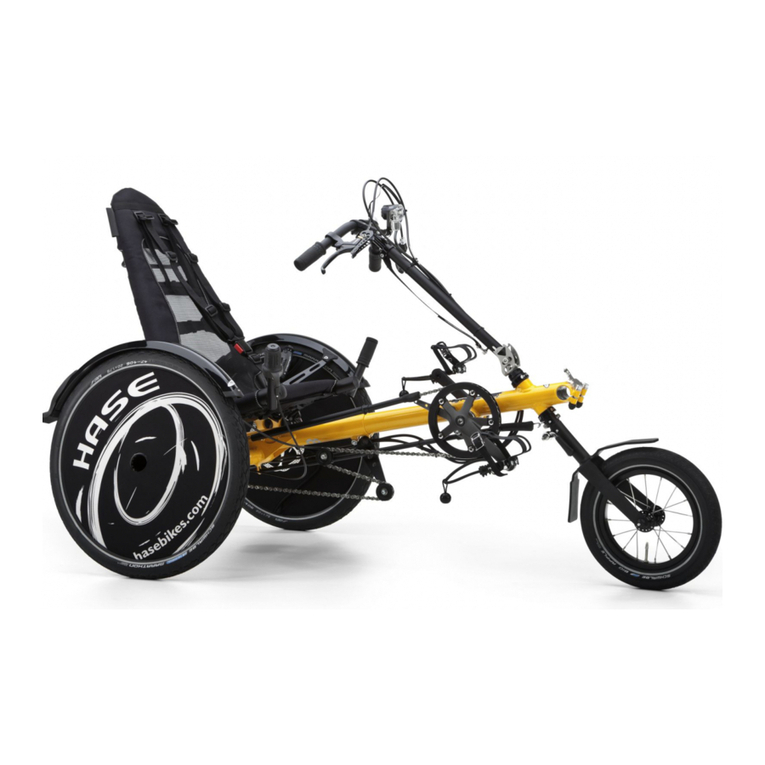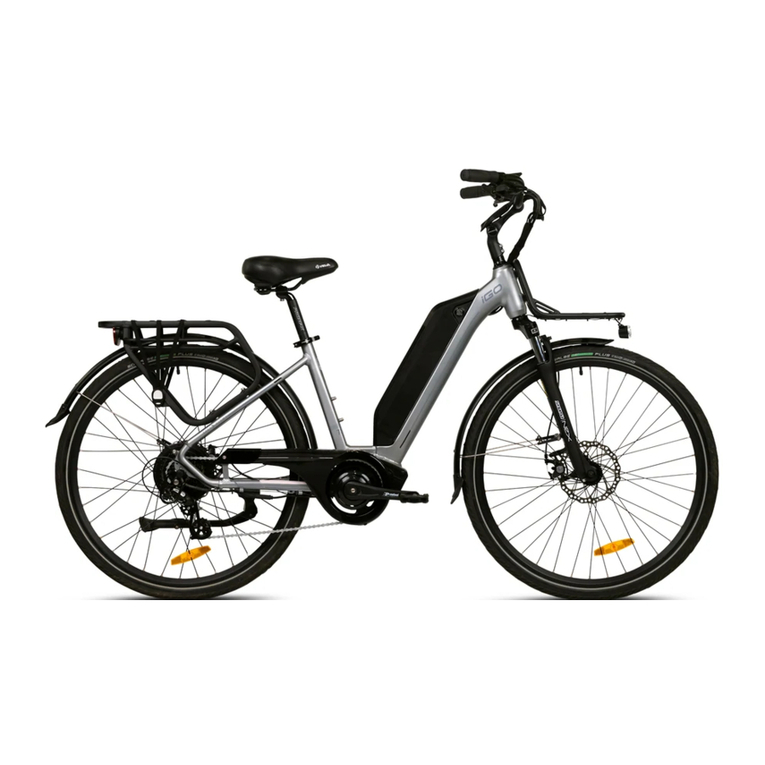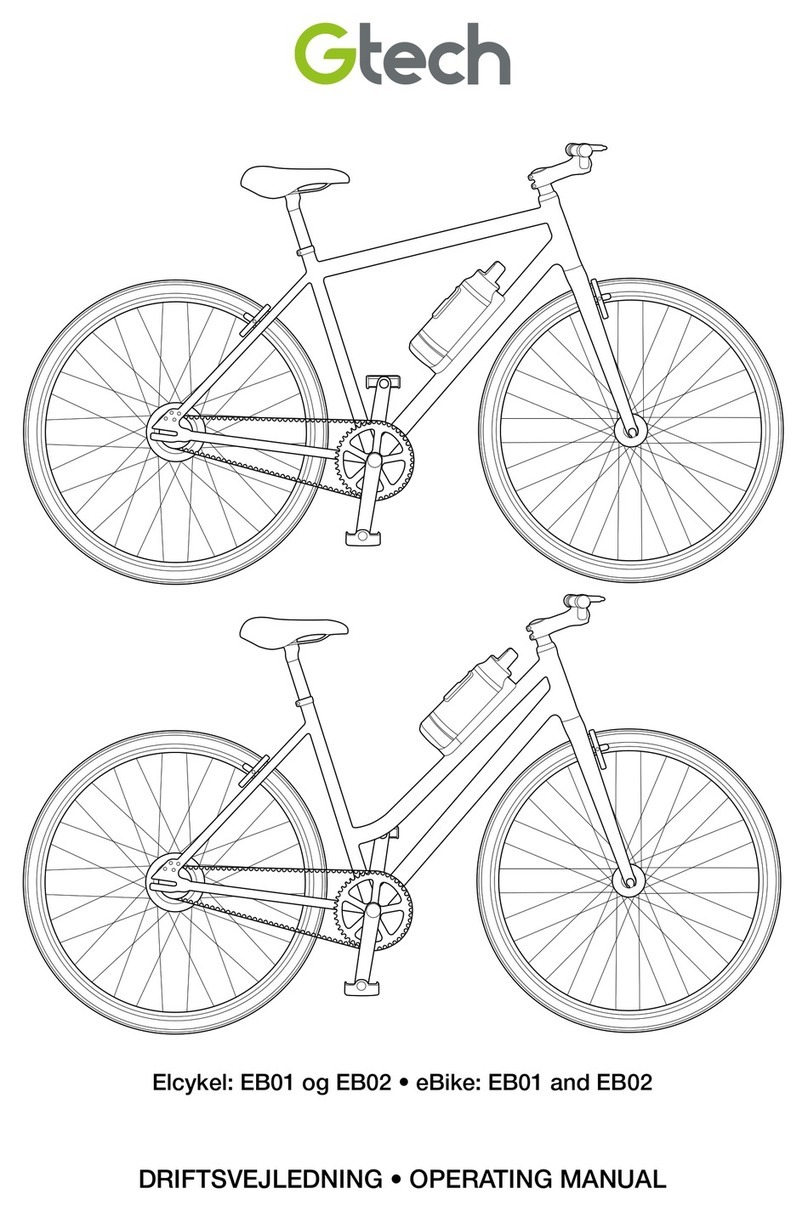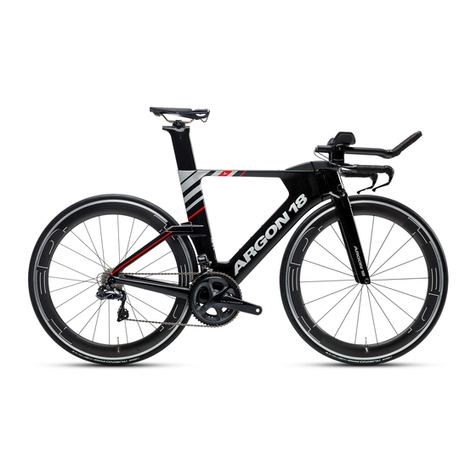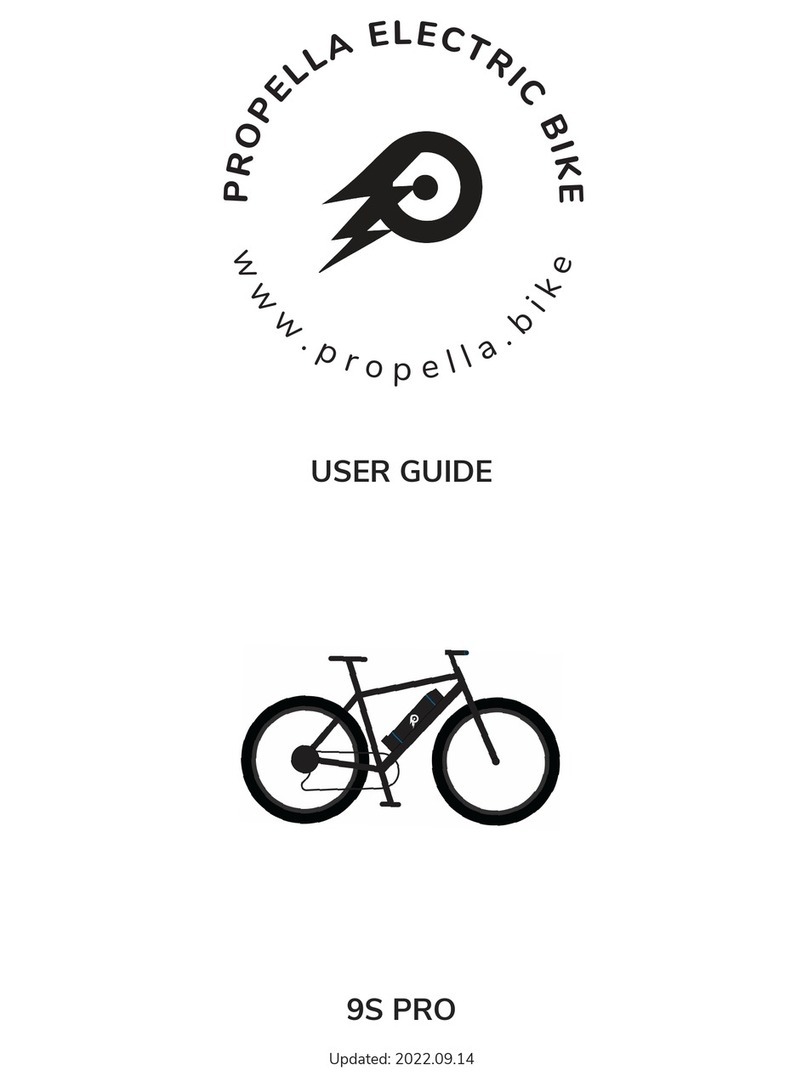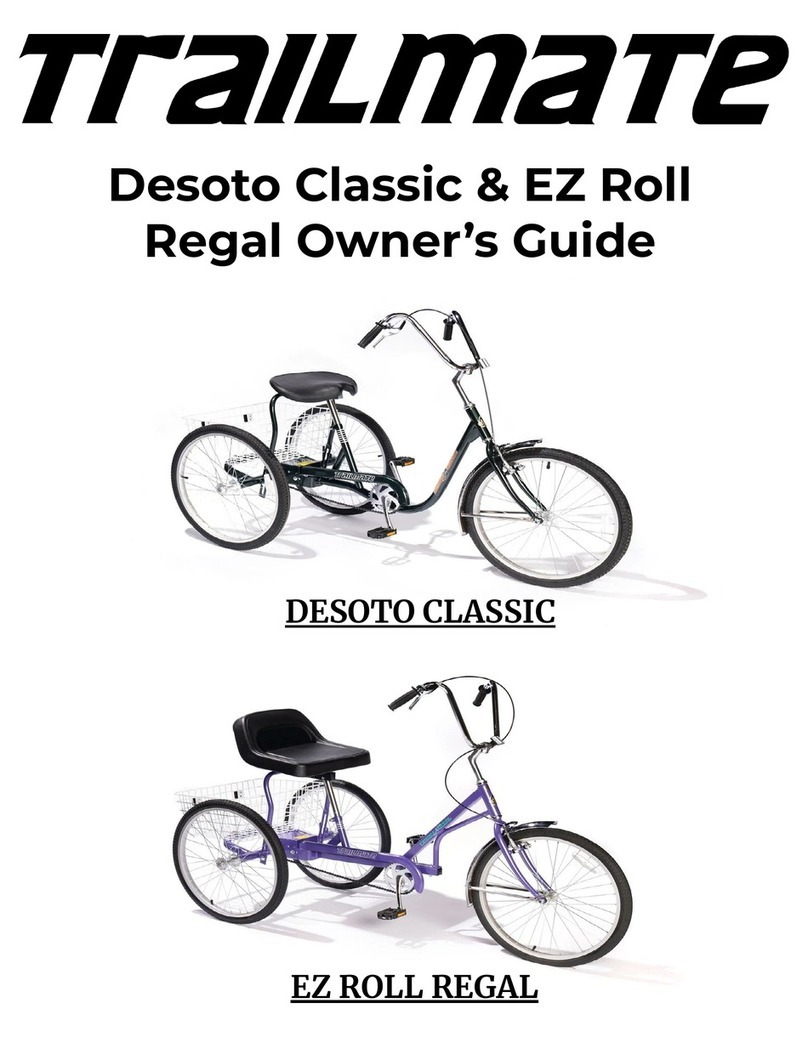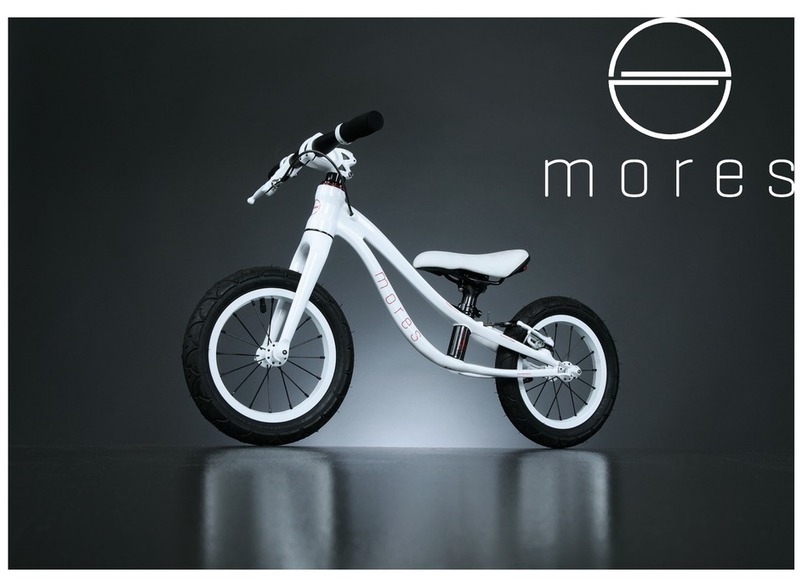Green Gear Cycling Bike Friday OSATA Guide

1
www.bikefriday.com800-777-0258 • +1-541-687-0487
Using Your Bike Friday®
OSATA
Green Gear Cycling, Inc.
3364 W 11th Ave. Eugene, OR 97402
800-777-0258 USA & Canada
+1-541-687-0487 Int’l • +1-541-687-0403 Fax
www.bikefriday.com • info@bikefriday.com
version 3/4/14

2 3
www.bikefriday.com www.bikefriday.com800-777-0258 • +1-541-687-0487 800-777-0258 • +1-541-687-0487
Table of Contents
The story behind OSATA 4
The growth of OSATA 5
Anatomy of a Bike Friday OSATA 6
Anatomy of a Bike Friday OSATA: Closeup 7
A Word on Safety / Your Tools 8
Congratulations / If You Need Help 9
Unpacking your OSATA 10
Assembly: Connect Frame 11
Remove Fork / Frame Spreaders 11
Install Rear Wheel 11
Install Front Wheel Quick Release 12
Easy Pack Mast 12
Using a Quick Release 13-14
Assembly: Reconnect Linear Pull / V-Brake 15
Adding Brake Cable Slack 16
Stem Safety Check 16
Mount the Stem Riser 17
Double Check Steering 17
Install Pedals 18
Double Check Your Bike Friday 19
Adjusting your OSATA: Frame Size 20
Saddle Height 20
Handlebar Height 21-22
Quill Stem Handlebars 22
Main Frame: Archer Technique 23-24
Main Frame: Gravity Technique 24-25
Main Frame: Two-Person Technique 25-26
Adjusting Headset 26-29
Packing in TravelCase: 30
Remove Accessories 30
Remove Pedals 30
Separate Main Frame 30
Remove Seatmast / Seatpost 31
Open Front and Rear Brake 31
Remove Front Wheel 32
Remove Rear Wheel 32
Install Fork Spreader 32
Table of Contents
Install Rear Wheel Dropout Spreader 32
Handlebars 33
Placing OSATA into TravelCase 34-36
Accessories: Travel Trailer Parts and Assembly 37-39
Dual Drive Hub Information 40
Bike Friday Service Overhauls 40
Bike Friday Service 41
More Maintenance Tips and Information 42-44
Airport and Travel Tips 45
Warranty Information 46-47

4 5
www.bikefriday.com www.bikefriday.com800-777-0258 • +1-541-687-0487 800-777-0258 • +1-541-687-0487
The story behind OSATA
A note from Bike Friday Co-Founder Alan Scholz:
Thank you for purchasing our Bike Friday OSATA. Your bike
is an example of the wonderful empowering relationships
we have with our customers.
The idea of an adjustable frame bicycle came from our ser-
vice expert Tim Link, who mentioned to me that a number
of customers over the years expressed interest in the abil-
ity for multiple users to share the same Bike Friday.
That idea simmered in my head for awhile. Then our lo-
cal Safe Routes to School Coordinator Shane MacRhodes
stopped by one day to discuss a idea of his.
The school program that teaches kids to ride safely uses
eet bicycles. Most of them are built in China, and Shane
wanted to see if he could get a bike built right here in Or-
egon.
Knowing the challenges of tting bikes to a class of middle
schoolers of various sizes and shapes, those two ideas came
together. Thus, the birth of the OSATA.
OSATA stands for One Size Adjusts to All Types. Families can
share bikes. Rental eets don’t have to be so large. And
school kids can learn on a bike that ts.
I hope you enjoy your ride,
Alan Scholz
A Safe Routes to
School class in
Eugene riding a eet
of 40 Bike Friday
OSATAs.
From School Training bike to a full line
Since its inception as a superior bicycle training bike, the
OSATA family has grown.
It is now Bike Friday’s fastest packing bicycle for travel.
The typical pack time after you have learned the basics
is 10-15 minutes. That’s all it will take to get the OSATA
packed into a TravelCase and ready to y.
The OSATA is now available in a Road version, Touring ver-
sion, City / Hub gear version and even a long Cargo Bike
version.
All OSATAs have multi-person t capability and come at
Bike Friday’s most affordable prices, starting less than
$500.
The growth of OSATA
The OSATA Road version is a lightweight, responsive Bike Friday
with 1 3/8th inch tires and plenty of gears.

6 7
www.bikefriday.com www.bikefriday.com800-777-0258 • +1-541-687-0487 800-777-0258 • +1-541-687-0487
Anatomy of an OSATA Anatomy of a OSATA: Closeups

8 9
www.bikefriday.com www.bikefriday.com800-777-0258 • +1-541-687-0487 800-777-0258 • +1-541-687-0487
A Word on Safety
Bicycles are a lot of fun, but improper use can result in
harm. Please, always ride safely!
• Always wear a helmet.
• Follow the rules of the road, and be courteous.
• Use front and rear lights after dark.
• Dress appropriately for the weather, the season, and
lighting conditions. Be seen!
• Always carry a spare tube, patch kit, pump and a tool
kit.
• Keep your bicycle in good shape.
• Check your tire pressure before every ride.
• Make sure all quick releases are secure.
• Have your bicycle routinely serviced for trouble-free
travels.
Your Tools
All Bike Friday bicycles are delivered with a com-
bination 5/6mm S-wrench [right] that is attached
to your water bottle cage. This wrench should
get your new bike on the road (along with your
own pedal wrench). Leave it in your bottle cage
so that you always have it handy.
All bikes ordered with
a TravelCase™ suitcase
also come with a tool
pouch [right]. In the
tool pouch you will nd
some cotton gloves to
keep your hands clean,
a folding tool set, and
a 4mm ball-end driver.
We also sell more
extensive tool kits for
home repair work. We
encourage you to learn
how to work on your
own bike. If you are not
familiar with bicycle maintenance, consider taking a local
class. It will improve your condence and self-sufciency as
you venture across the globe.
Extra Accessories
We also sell an extensive line of bicycle and travel
accessories. Whether you are riding the local back roads
or venturing into foreign lands we have the gear you need.
Call us for information on spare tires, tubes, replacement
parts, fenders, racks, bags, or other items to complete your
Travel System. You can purchase these products from our
online store: www.store.bikefriday.com
Congratulations!
You have just purchased the nest travel bicycle available
today. Your bike has been carefully designed and con-
structed for your personal travel needs. All of our bikes are
manufactured in our Eugene, Oregon factory by real
cyclists who care about our customers and our products.
Please take your time reviewing this manual before you
assemble your new Bike Friday. You will nd your new
bicycle to be simple and reliable anywhere you go!
More Information
To check out our products, nd other useful information,
discover Bike Friday events and Yak with other Bike Friday
owners on the bulletin board, go to our main website at:
www.bikefriday.com
Blue skies and happy trails from Green Gear Cycling
If You Need Help . . .
If you need technical assistance with any Green Gear®
Cycling product, or are unclear on the proper operation of
your Bike Friday, please call us and a Service Technician
will help you get back on the road. Our toll-free number in
the US and Canada is 800-777-0258; international is +1-541-
687-0487. Normal business hours are 8:30 a.m. to 5:30 p.m.
Monday through Friday, and 9 a.m. to 4 p.m. Saturdays,
Pacic Time. You can also email service questions to
service@bikefriday.com.
Because we understand the needs of world travelers, we
offer 24-hour technical support in emergencies. If necessary,
please call our regular number and our answering service
can forward you to a Service Technician on call.
Welcome to the Community

10 11
www.bikefriday.com www.bikefriday.com800-777-0258 • +1-541-687-0487 800-777-0258 • +1-541-687-0487
Unpacking your OSATA
Unpacking Your OSATA From a Box or TravelCase
Opening your box or TravelCase may present an intimidat-
ing sight, particularly if you ordered many accessories.
Do not worry; we work hard to keep our products as
simple as possible. We recommend nding a quiet area
and some room to spread out.
This manual will address the fundamentals of packing,
assembly and adjusting techniques. However, because
your bicycle was built for you, you might discover that
your bike was packed at the factory slightly different than
the one in this manual.
You do not, however, have to repack your bike in exactly
the same fashion as this manual suggests. You may nd a
better way of stowing your accessories and we encourage
you to experiment.
Your OSATA should only require minimal assembly. It will
take approximately 15-45 minutes and require a basic
level of technical skill.
You will need a 5/6mm hex wrench (included), a 15mm
open wrench (or pedal wrench) and a pair of scissors (or
better yet wire cutters, snips or diagonal cutters) to cut
zip ties.
Take care not to damage the frame while cutting zip ties.
[Note: Depending on the components you have purchased
with your Bike Friday, your specic model may require
other tools for adjustments.]
Open the box or TravelCase and remove the bike from the
container. Remove the bubble wrap or felt covers and lay
the disassembled bike out on front of you.
Connect Front and Rear Frame Sections
With a hand holding the front and rear sections respec-
tively, insert the front (male) section into the rear
(female) section of the main frame. Ensure that the snap
/ spring button slips into one of the 4 holes.
Install the Rear Wheel
Release (spread open) the rear brake and make sure you
are in the highest gear (largest #) on the right side (rear)
shifter. [SEE PAGE 12 FOR BRAKE RELEASE OPERATION] To
install the rear wheel, grasp the derailleur body and pivot
it backward to make it easier to insert the wheel into the
dropouts. When putting the rear wheel into the dropout,
align the chain with the smallest cog of the cassette.
Fasten the rear quick release skewer (or rear axle bolts on
a Dual Drive hub).
Assembling your OSATA
Fig. 2 Grasp Derailleur body. Fig. 3 Fasten quick release.
Remove Fork/Frame Spreaders
The PVC tubing in between your
fork legs and rear dropouts are
intended to help prevent damage
when traveling. They are held in
place with wheel quick release
skewers. Open the quick release,
unthread the knurled nut, and
put the spreaders in the tool
pouch for future use. Fig. 1 Fork speader.

12 13
www.bikefriday.com www.bikefriday.com800-777-0258 • +1-541-687-0487 800-777-0258 • +1-541-687-0487
Assembling your OSATA
Install Front Wheel QR
Open the front brake release,
then position the front wheel
making certain that the wheel
axle is fully seated in the front
dropouts.
Now install the quick release
from the fork spreader on the
front wheel. Make certain that
there is one spring per side of
the hub axle and that the small
end of the spring is pointing
toward the center of the hub.
Loosely thread on the knurled
nut for now.
Fig. 4 Front Wheel QR.
Mechanic’s Tip: If you are ever unsure of the proper
direction of the front tire, looking down at the tire,
the tread should be oriented so that it is pointing for-
ward. Often the tread is in a arrow-ish pattern and this
makes it easy to point it in the forward direction. The
quick release levers, front and back are to be placed on
the non-drive side of the bicycle.
Easy Pack Mast
The OSATA bicycle models have a seat-
mast that telescopes out of the lower
seat tube. Install the seatmast into the
seat tube. Note the minimum insertion
mark etched at 4” from the bottom on
the mast. This is the minimum amount
of the mast that must be inserted (over-
lapped) in the frame. Tighten the bolt
on the seatmast clamping collar.
Fig. 5 Insert
seatmast.
Using a Quick Release
Using Those Nifty Quick Releases
On a cold and snowy day in the 1927 Gran Premio della
Vittoria, a tired and numb Tullio Campagnolo struggled
with the frozen wing nuts on his rear wheel while trying to
change gears. In a moment of frustration and inspiration
Campagnolo envisioned the modern quick release. The
bicycle world was transformed.
The quick release is one of those simple but great inventions
that really makes life better. However, if used incorrectly,
you can potentially endanger yourself. Although a reliable
and safe product, some people have been injured because
they didn’t know how to properly use this elegant device.
Your Bike Friday OSATA has several of them. If you are not
familiar with their operation, PLEASE study these directions
carefully. If you are still unclear on their operation, call us or
contact your favorite local bike shop before you ride!
Quick Release Operation
A quick release is a simple cam with a lever that swings
through an arc that is square to the axle. As the lever moves,
the cam clamps the wheel to the frame, or secures the frame
joint. It is not a wing nut to be rotated around the axle.
The tension on the quick release is controlled by how tight
the knurled nut on the other end is set. Only wheel quick
releases have the small cone-shaped springs. Note that the
small ends of the springs face toward the center of the hub.
Quick Release Maintenance
We recommend adding a few drops of light oil to the lever
where it enters the cap several times per year. This will
keep your quick release working smoothly for years.
Open
Close
Knurled Nut
(adjust tightness here)
QR Lever
(Loose)
(Starts getting
tight here)
(Stiff)
Springs
Cam

14 15
www.bikefriday.com www.bikefriday.com800-777-0258 • +1-541-687-0487 800-777-0258 • +1-541-687-0487
Using a Quick Release
Double-Check!
Ideally, the quick release
lever should be facing
the rear, or upward.
Levers that are facing
forward can catch on any
number of things and be
accidentally opened. Fig. 8 Closed QR points toward rear.
Adjust Knurled Nut
With the wheel installed
and the axle properly
seated in the frame (or
the frame joint closed),
position the quick release
lever so that it is in line
with the axle. Then turn
the knurled nut on the
other side clockwise until
it is snug. When the quick
release is properly adjusted, you should be able to freely
swing the quick release lever for the rst half of its arc, at
which point the lever should offer resistance.
Fig. 6 Quick release operation.
Continue Closing QR
Using the palm of your
hand press the quick
release lever through the
rest of its arc until the
lever is closed and parallel
to the wheel. You should
feel very rm resistance
when the quick release
is properly adjusted (the
lever may even leave a
light imprint in the palm of your hand).
Fig. 7 Setting quick release tightness.
Assembling your OSATA
Reconnect Linear Pull
Brakes / V-Brakes
To close the V-brake to the
riding position, while fac-
ing the brake, with your
left hand (index nger and
thumb), grab the noodle
carrier and with your right
hand grab the noodle and
slip the noodle tip into the
slot on the noodle carrier.
If you cannot get enough
“slack” to put the noodle
tip into the noodle holder,
then the brake cable may
need to be loosened a
bit. See the next step for
instructions to add some
slack to the cable. Repeat
this procedure on the rear
brake.
Mechanic’s Tip: Sometimes
the cable housing can come
unseated either where it
enters the noodle or where
the housing enters the
brake lever barrel adjuster.
If the housing is unseated,
it will not be possible
insert the noodle tip into
the noodle holder. In fact,
it will make the process
quite frustrating; make
sure the housing is properly
seated at both ends.
Fig. 9 V-brake open.
Fig. 10 Grab the noodle carrier.
Fig. 11 Slip noodle into slot.
Fig. 12 V-brake closed.
NOODLE
NOODLE
CARRIER

16 17
www.bikefriday.com www.bikefriday.com800-777-0258 • +1-541-687-0487 800-777-0258 • +1-541-687-0487
Adding Cable Slack
to V-Brakes
To increase slack in the
brake cable, you can turn
the barrel adjuster on the
brake lever. The barrel
adjuster is the knurled
bolt that the cable hous-
ing goes through as it
enters the brake lever.
Turn this adjuster clock-
wise (inward toward the
brake lever) to loosen the cable. Conversely, if you want
to bring the brake pads closer to the rim to compensate for
cable stretch from use, unscrew the barrel adjuster away
from the brake lever. Note: Some models may have a lock
nut on the adjuster, which will need to be loosened rst.
ALWAYS DOUBLE CHECK YOUR BRAKES BEFORE RIDING.
Fig. 13 Brake barrel adjuster.
Barrel
Adjuster
Assembling your OSATA
Fig. 14 Stem pin.
Stem Safety Check
If you look carefully at the base of
your stem from the underside, you will
see a pin hidden under the clamping
collar. This pin must engage the slot
in the back of the fork’s steerer tube
(the unpainted tube sticking up from
the frame’s headtube.) Additionally,
the stem should be fully seated onto
the fork steerer tube.
Mount the Stem Riser
Slide the bottom of the stem
riser onto the fork steerer
tube, keeping the stem riser’s
lower clamp forward so the
hidden stem pin will engage
the slot in the fork. Gently
press the stem all the way
down. You should feel it
“bottoming out” on the end of
the slot. Once the lower stem
riser is in place, tighten lower
stem riser bolt. NOTE: Do not
adjust the locking headset
spacer.
Assembling your OSATA
Fig. 15 Lower stem riser.
Upper Stem
Riser Bolt
Lower Stem
Riser Bolt
Locking
Headset
Spacer
Double Check Your Steering System Integrity:
Now is a good time to double check your steering system.
Try standing in front of your bike with your front wheel
between your legs. Twist the bars to make sure everything
is secure, that the bars do not turn independent of the
fork /front wheel.
Fig. 16 Mounting stem
riser, part 1.
Fig. 17 Mounting stem
riser, part 2.

18 19
www.bikefriday.com www.bikefriday.com800-777-0258 • +1-541-687-0487 800-777-0258 • +1-541-687-0487
Pedal Thread Directions
Bike pedals have two dif-
ferent thread directions.
The right pedal has a
right-hand (clockwise)
thread, and the left pedal
has a left-hand (counter-
clockwise) thread. Pedals
are usually stamped with
an R or L on the pedal
axle near the threads.
Always grease your pedal
threads on new pedals
before their rst instal-
lation.
Fig. 18 Pedal tightening for drive side.
Reverse direction for non-drive side.
Loosen
Tighten
Installing Pedals
Mechanic’s Tip: The quick and easy way to remember which
way to thread your pedals on is applicable to either side of
the bike [SEE PHOTO ABOVE]. You can put a wrench on the
pedal’s wrench ats, and using a back pedaling motion will
screw the pedals on. Use grease before threading pedals.
Note: We recommend starting thread engagement with your
hands instead of a wrench (see below), so use this tip as
a practical way to know which way to begin threading the
pedals.
Thread in the Pedals
Using your nger, start the pedal threads into the proper
crank arm. Be careful not to cross-thread the pedals! Once
the pedal threads are started, you may use a wrench to n-
ish threading them in, and then tighten securely.
Mechanic’s Tip: The threads on a pedal are steel (hard) and
the threads on a crank arm are aluminum (soft). It is very
important that the pedal is tightly secured to the crank arm.
With grease on threads there is no need to over tighten. If
the pedals are not tightly secured, the “slop or play” in the
connection will allow the steel threads to rip out the alu-
minum crank threads. Your bicycle may have shipped with
a set of pedal washers. For some cranks, the use of the
washer in between the pedal and the crank arm creates a
more solid and secure base or foundation for the pedal to
contact the crank arm with. If included, use them!
Assembly: Pedals Double Check Your Friday
Double Check Your Bike Friday!
At this point your bike should be ready to ride. However,
before you ride away, be sure to double-check your assembly.
• Are the handlebars tight?
• How about the stem and pedals?
• Are the quick releases all secure?
• Is the saddle secure and at a reasonable angle?
• Are the handlebar and control levers in a proper place
and clamped tight?
Although we always inate the tires at the factory, check
your tire pressure for proper ination. Under-inated tires
not only wear faster and are more prone to ats, but they
also add rolling resistance.
Be sure to have at least the 5/6mm S wrench in the mono
tube bottle cage for quick roadside adjustments. If you have
the folding tool, take it with you. You will probably want to
stop and adjust saddle height and the angle, as well as per-
haps adjust a few other items during your rst ride or two.
Mechanic’s Tip: Grease is your friend. Be sure to keep a light
lm of grease on any intersecting bike parts. This will help
to prevent corrosion, facilitate disassembly, and eliminate
annoying noises. Areas include: OSATA Main Frame coupling
joint, seatposts, saddle rails, handlebars, stems, pedal
threads and seatmast. Doing this a couple of times per year
during routine maintenance should be enough. Wipe off any
excess or visible grease. Also be sure to lightly grease all
bolt threads on your bicycle as you repair or upgrade com-
ponents. Lubricating your bolts will allow you to adequately
tighten the fasteners and keep them from seizing in the
future.

20 21
www.bikefriday.com www.bikefriday.com800-777-0258 • +1-541-687-0487 800-777-0258 • +1-541-687-0487
How to Adjust Your OSATA to Fit Each Individual Rider
The OSATA is adjustable to a wide range of riders. Adjust-
ments can be made to the main frame (frame size) as well as
the seatmast / saddle height and stem / handlebar height.
Frame Size: The OSATA frame can be adjusted between a 46
cm and 58 cm in 4 cm increments. Additional adjustments
can be made by swapping out the stem with one of a differ-
ent projection.
If you are comfortable with your current bike, you can use
that measurement as a guideline for your frame adjustment.
If you experience pain in your neck, shoulders, back or knees
from your current bike, you might want to go to a bike shop
that offers tting. They can nd the correct size to set your
OSATA to for a perfect t.
Adjusting your OSATA
Saddle Height: Proper saddle height is important in prevent-
ing injuries as well as increasing riding efciency and com-
fort. A rough rule of thumb method for determining proper
saddle height is when the pedal is in the 6 o’clock position,
your leg should have a slight bend in it with the ball of your
foot centered on the pedal, your knee almost fully extended
(but not quite). A quick way of achieving this is to raise your
saddle in small increments until you notice your leg is fully
extended in the 6 o’clock position and then lower the saddle
slightly. Rocking your hips to be able to reach the pedals
during the pedal stroke is to be avoided.
Special Feature: If you require the saddle to be lower than
the current lowest setting, you can purchase a shim and
seatpost from Bike Friday so the seat post is usable directly
inserted into the mainframe without the use of the seatmast.
Fig. 19 Lower Seatmast, shim.
Fig. 20 Lower Seatmast no
seatpost.
Handlebar Height: This is a subjective preference. Handle-
bar height can be classied into three general categories: 1)
bars below saddle; 2) bars level with saddle; 3) bars higher
than saddle.
For reference you can use an existing comfortable bike or
you can try out the three settings and see which one works
best for you.
Do note that humans tend to acclimate to whatever position
we are given to the point that we may subsequently be set
up with a properly sized bike and it will feel improper.
You may nd it quite constructive to try a few positions, just
be sure to try them out for more than a few minutes because
that initial period may feel awkward, but possibly because
you have acclimated to incorrect sizing.
The beauty of the OSATA is the ability to try and use a wide
range of positions on the bike.
Adjusting OSATA: Handlebar
Fig. 21 Loosen lower stem riser.
Upper Stem
Riser Bolt
Lower Stem
Riser Bolt
Locking
Headset
Spacer
• Locking headset spacer.
This static spacer is for
headset adjustment. DO
NOT loosen this bolt unless
you are disassembling the
fork from the frame OR if
you are adjusting the head-
set bearings.
• Lower stem riser bolt. This
bolt is used to afx the stem
riser to the fork / frame.
• Upper stem riser bolt. This
bolt allows you to adjust the
height of the handlebars.
Stem Riser, Headset Spacer Anatomy
Mechanic’s Tip:
The minimum insertion mark is QUITE
important. It indicates the minimum
amount of overlap of the two tubes that is
safe, any amount of overlap less than this
(if the entire minimum insertion mark is
showing) is NOT SAFE.
Fig. 21.1 Hash marks.

22 23
www.bikefriday.com www.bikefriday.com800-777-0258 • +1-541-687-0487 800-777-0258 • +1-541-687-0487
Adjusting OSATA: Handlebars
Fig. 22 Loosen upper stem riser.
Upper Stem
Riser Bolt
Lower Stem
Riser Bolt
Locking
Headset
Spacer
Adjusting Handlebar Height.
Loosen the upper stem riser
bolt, adjust the height as
needed and re-tighten. If you
are having difculty adjusting
the height with the upper stem
riser bolt loose, you may nd
that also loosening the lower
stem bolt will make it easier to
change the height. Just remem-
ber to tighten both bolts when
done. DO NOT LOOSEN THE
LOCKING HEADSET SPACER.
NOTE: There is a “minimum insertion” mark etched about
4” from the bottom of the stem riser, this is the amount
of material that must be inserted for safe use.
Quill Stem Adjustments
NOTE: For customers that have a “quill” style stem, you
have an extra set of height adjustments with the quill stem.
To loosen the quill stem, loosen the main bolt.
You are likely going to have to “un-wedge” the internal
wedge in the quill stem. This can be done in one of two ways:
• Stand in front of the bike, with your legs surrounding the
front wheel to prevent it from turning, turn the handle-
bars, you should feel it all of a sudden give and now the
bars will turn independent of the wheel.
• Unscrew the bolt that runs in the center of the stem
(toward the fork). Continue until the head of the bolt
sticks up a bit and with a mallet (or a hammer and a piece
of wood to prevent any deformation of the bolt head),
strike the bolt head in a downward motion toward the
fork. This will unseat the wedge allowing you to adjust or
remove the stem.
Fig. 23 Quill Stem adjustment. Fig. 24 Quill Stem unwedge.
Adjusting OSATA: Main Frame
Adjusting the Main Frame Sizing
Adjusting the main frame size can be done by one person but
is easier with two. If you are encountering any resistance
depressing the button, getting the button to pop back out or
telescoping the frame in and out, wiggling the two sections
(up and down or a rotating motion) will make your life much
easier.
Your OSATA should have come with grease in this area, over
time you might need to re-apply some to make the sizing
task easier. Embrace the grease.
One Person “Archer” Technique (archer because the hand
position resembles an archer’s stance)
Fig. 25 Main Frame Pinch Bolts.
Make Frame Larger
• Loosen the two Main Frame
pinch bolts that secure the
clamps on the telescoping
main frame.
• Depress the spring loaded
button, move the male
and female portion of the
frame side by side slightly
so that the button remains
depressed so you can con-
tinue with the adjustment.
Mechanic’s Tip: Wiggle it a
bit if you are encountering
resistance. Alternatively, if
you are encountering resis-
tance, putting your hand on
the bottom of the rear sec-
tion where the binder bolts
are, pushing up a bit will free
up the binding sensation you
are feeling (creating up and
down movement between the
front and rear sections). The
Two-Person technique can be
easier.
Fig. 26 Archer Position.
Main Frame
Pinch Bolts
Spring Loaded
Button
Fig. 27 Wiggle.

24 25
www.bikefriday.com www.bikefriday.com800-777-0258 • +1-541-687-0487 800-777-0258 • +1-541-687-0487
Fig. 28 Wiggle.
Adjusting OSATA: Main Frame
Make Frame Larger (cont.)
• Kneeling in front of the
bicycle while facing it,
place one hand on the
seatmast a few inches
above where it enters the
main frame and the other
hand on the stem riser
right above the headset
and push or pull with a
concurrent twisting or
wiggling motion. IT IS ALL
ABOUT THE WIGGLE!
Make Frame Larger
• Loosen the two Main Frame
pinch bolts that secure the
clamps on the telescoping
main frame.
• Depress the spring loaded
main frame button, move
the male and female por-
tion of the frame side by
side slightly so that the
button remains depressed.
Wiggle it a bit.
Make Frame Smaller
Same steps as above but push frame parts together instead
of pulling them apart.
Alternative One Person “Gravity” Technique (if you are
having difculty sizing the bike, this technique may be
easier, some bikes this seems to work better on than
others).
Fig. 29 Main Frame Pinch Bolts.
Main Frame
Pinch Bolts
Spring Loaded
Button
Adjusting OSATA: Main Frame
Fig. 30 Gravity Technique.
Make Frame Larger (cont.)
• Lift the front wheel so it
is close to being directly
above the rear wheel.
• With one hand on the stem
riser and one hand on the
fork, lift the bike until
the rear wheel is off the
ground and the rear half
should slide downward.
Make Frame Shorter
• Same steps as above but
push downward on the
headtube (parts of the
frame separating the fork
and the stem riser where
the headset is mounted on
either end).
Two Person Technique (easiest method)
Fig. 31 Two Person Technique.
Make Frame Larger
Rear person: Stabilize the rear
end while the front person
pulls the bike away to make
larger.
Concurrently:
• Depress the spring loaded button with the left hand.
• Put your right foot in front of the rear tire (to prevent
the rear wheel / rear end from moving forward).
• Apply downward pressure and place your right hand at
the bottom of the seatmast.

26 27
www.bikefriday.com www.bikefriday.com800-777-0258 • +1-541-687-0487 800-777-0258 • +1-541-687-0487
Adjusting OSATA
Two Person Technique, Make Frame Larger (cont.)
• Front person: Stand facing the front of the bike.
• Place one hand on the fork blade, the other hand on the
stem riser.
• Using a twisting motion, pull on the bike until it clicks
into the desired position.
Make Frame Smaller
• Same steps as above but push frame parts together
instead of pull apart.
The OSATA uses a unique bearing
preload system that can be adjusted
with or without specialized tools.
The installed system will hold or
secure a headset adjustment, but
you will need either a specialized or
improvised tool to adjust the head-
set preload, for instance if the head-
set adjustment seems loose or overly
tight.
A headset can be adjusted into one
of three states:
Loose When you grasp the front
brake and try to move the front
wheel forward and backward, you
feel “play” or slop in this connec-
tion. This suggests the bearings are
loose.
Adjusting the Headset
Fig. 32 Headset Anatomy.
Locking
Headset
Spacer
Tight While raising the bicycle in the air with the front wheel
lower than the back wheel, very lightly turn the stem to one
side and see if, the stem / wheels returns to the forward
position smoothly. If the stem / wheel’s movement is notchy
and not smooth, the headset bearings are too tight.
Just right No play and rotates smoothly.
Adjusting OSATA: Headset
Tap Adjust Method (Using
Improvised Tools)
Remove the seatpost from the
seatmast and the seatmast
from the bike and the collar
from the seatmast.
Mechanic’s Tip: Mark the seat-
post (where it enters the seat-
mast) and seatmast (where it
enters the main frame) with a
piece of electrical tape. This
will allow you to re-assemble
the post and mast to the pre-
vious seat height.
Remove the stem riser and O
rings (if applicable) from the
steerer tube, let them hang
beside the bike.
Loosen the locking headset
spacer (note, with this clamp
loose, the fork and headset
can easily fall apart unexpect-
edly.) It should be just loose
enough to turn with your n-
gers, but not any looser.
Remove excess space between
the headset pieces. Do this by
lifting the fork a few inches
off the ground with one hand
on the fork leg while the other
hand pushes down on the
headset xed clamp.
Tighten the locking headset
spacer slightly so there is
some resistance on the bolt,
but not fully tight.
Fig. 33 Seatmast Removal.
Fig. 34 Remove Stem Riser.
Fig. 35 Loosen Locking Headset
Spacer.
Fig. 36 Remove Excess Space.

28 29
www.bikefriday.com www.bikefriday.com800-777-0258 • +1-541-687-0487 800-777-0258 • +1-541-687-0487
Tap Adjust Method (cont.)
Place the seatmast over the
steerer tube.
While lifting upward on the
fork with one hand, tap
downward on the seatmast to
compact / add preload to the
headset with a mallet or block
of wood and hammer.
Tighten the headset xed
clamp, install the stem riser
(fully tightening the bolts),
and check headset adjust-
ment.
Repeat as necessary
Fig. 37 Strike Seatmast.
Adjusting OSATA: Headset
Fig. 38 Headset Press Tool.
Remove the stem riser and,
O rings (if applicable) from
the steerer tube. Let them
hang beside the bike.
Loosen the headset xed
clamp.
OSATA Headset Press Tool, available from Bike Friday (with
specialized tools)
Adjusting OSATA: Headset
From the bottom, move the
washer onto the rod and
thread the nut onto the rod.
With a 10mm wrench (or
adjustable wrench) hold in
place the nut while tighten-
ing the bolt head with a hex
wrench, creating bearing pre-
load. It is helpful to evaluate
the headset adjustment with
the tool still in place.
Fully tighten the locking head-
set spacer. [Figure 41]
Fig. 39 Headset Press Tool.
Remove the washer and nut
from the bottom of the tool.
[Figure 39]
Slide the rest of the tool, from
the top, allowing the 1¼”
tubing to cover the portion of
exposed steerer tube. [Figure
40]
OSATA Headset Press Tool (cont.)
Fig. 40 Headset PressSetup.
Fig. 41 Headset Press Tighten.
Remove the tool, reassemble and test for bearing adjust-
ment. Repeat if necessary.

30 31
www.bikefriday.com www.bikefriday.com800-777-0258 • +1-541-687-0487 800-777-0258 • +1-541-687-0487
As you might already know, your Bike Friday conveniently
packs into a hard shelled airline accepted suitcase. As you
pack your bike more often and become more familiar with
the process, your packing times will likely decrease over
time. Expect to spend between 15-60 minutes packing your
bike in a TravelCase (once you are familiar with the process).
Remove the Pedals
Loosen your pedals with
a pedal wrench. The right
pedal unthreads in a coun-
ter-clockwise direction and
the left pedal un-threads
in a clockwise direction.
(Remember that both ped-
als turn toward the rear of
the bike.) Place the pedals
in the blue felt bag labeled
“pedals.”
Separate Main Frame
Loosen the OSATA Main
Frame pinch bolts and
separate the two halves of
the main frame. Depress
the spring button, hold
the front wheel above the
rear wheel and use grav-
ity to assist in the separa-
tion of the main frame. If
this does not happen easy,
refer to the previous sec-
tion entitled “Adjusting
the Main Frame Sizing” for tips.
Fig. 43 Separate Main Frame Sections.
Packing: Into a TravelCase
Packing your OSATA into a TravelCase
Remove your Accessories, Set your Derailleur
Before disassembling and packing your Bike Friday OSATA,
remove all extra accessories including racks and water bottle
cages. Items that may remain on the bike include your cycle
computer mount, or pump.
Shift the rear derailluer to its smallest cog, [hardest gear}.
Fig. 42 Pedal tightening drive side.
Loosen
Tighten
Remove the Seatmast (and seat-
post as one complete unit)
Loosen the seatmast clamping
collar and remove the mast. The
saddle can remain attached to the
seatpost and the seatpost in the
mast.
The mast, however, will t better
in the TravelCase if you collapse
the seatpost in the mast (loosen
the seatpost collar bolt, collapse
the seatpost into the mast and
then lightly tighten the seatpost
collar clamp). Fig. 44 Collar Clamp
Open Front and Rear
Brakes
If you have V-brakes, grasp
the noodle carrier with
your left hand, and with
your right hand, grasp
the noodle and move the
noodle tip up and to the
left of the carrier, moving
the noodle out of the slot
in the carrier.
If you cannot release the
noodle from the noodle
holder, then the brake
cable may need to be
loosened a bit.
See instructions to add
some slack to the cable
on page 12.
Figs. 45 Grab the noodle and release
from the noodle carrier.
Packing: Brakes

32 33
www.bikefriday.com www.bikefriday.com800-777-0258 • +1-541-687-0487 800-777-0258 • +1-541-687-0487
Remove the Front Wheel
After removing the front
wheel, close the brake
again. Remove the quick
release from the axle by
undoing the knurled nut.
Be careful not to lose
the small cone-shaped
springs. Put the quick
release through the fork
spreader (the short PVC
dowel), and thread on the
knurled nut again. Both
small cone shaped springs should be on the quick release
shaft (with the cone points oriented inward).
Fig. 46 Remove the front wheel.
Install the Fork Spreader
Slip the fork spreader
between the dropouts
on the fork, and lightly
tighten the quick release.
The fork spreader will
help prevent damage to
your fork when traveling.
Fig. 47 Install fork spreader.
Install the Rear Wheel Dropout Spreader
Secure with the rear wheel quick release lever or in the case
of a Dual Drive hub you can use a zip tie.
Packing: Front Wheel
Remove the Rear Wheel
After removing the rear wheel, close the brake again. Remove
the quick release from the axle by undoing the knurled nut.
Be careful not to lose the small cone-shaped springs.
Remove Stem Riser
Loosen the stem riser lower
bolt and pull upward on the
handlebars
NOTE: YOU WILL BE LOOSENING
THE LOWER STEM RISER BOLT,
BUT NOT THE LOCKING HEAD-
SET SPACER. THIS IS IMPOR-
TANT, IF YOU ACCIDENTALLY
LOOSEN THE FIXED CLAMP, YOU
MAY NEED TO READJUST YOUR
HEADSET. [Pages 25-28]
Packing: Handlebars
Fig. 48 Loosen lower stem riser.
Upper Stem
Riser Bolt
Lower Stem
Riser Bolt
Locking
Headset
Spacer
Install Packing Materials on:
• Rear Derailleur
• Rear End
• Front End
• Stem Riser
• Handlebar
• Seatmast
• Saddle
• Pedals
• Chainstay, driveside (use the clear plastic piece of tub-
ing)
SEE ILLUSTRATION ON PAGE 34

34 35
www.bikefriday.com www.bikefriday.com800-777-0258 • +1-541-687-0487 800-777-0258 • +1-541-687-0487
Packing: OSATA in TravelCase
Fig. 50
Fig. 51
Fig. 52
Fig. 53
Placing the OSATA into a
TravelCase
Place the main frame protec-
tor (half of a crush protector)
in the open end of the rear
end half.
[Figure 50]
Place the front end of the
bike, with the head tube in
the Northeast corner. Allow
the handlebars to dangle out-
side, to the right of the case.
[Figure 51]
Place the rear end of the
bike in with the rear derail-
leur at the Southwest corner
of the case. The rear end will
t somewhat diagonally into
the case. Please make sure
the non drive crank arm is not
striking the fork. Point it to-
ward the headset. [Figure 52]
Place the handlebars in the
center of the case, bars to-
ward the North, stem riser
pointing South. [Figure 53]
Mechanics Tip: If you need
more slack to arrange the
handlebars, you can increase
slack by carefully pulling the
cable housing through the
housing loops on the frame.
Tip # 2: If needed, you can
loosen the handlebar clamp
bolt to allow you to rotate
the bars to provide more ex-
ibility in the t of the bar
controls in the case.

36 37
www.bikefriday.com www.bikefriday.com800-777-0258 • +1-541-687-0487 800-777-0258 • +1-541-687-0487
Fig. 54
Fig. 55
Fig. 56
Fig. 57
Place saddle / seatmast on
West wall with the mast
pointing East, through the
rear end.
Install the crush protector.
Place the bottom ange in
the case in the most central
spot as possible, install the
rod and this then provides a
guide as to the height of the
case. [Figure 54]
FOR TRAILER OWNERS Install
trailer frame, running the
long section along the South
edge. [Figure 55]
FOR TRAILER OWNERS Place
one of the trailer wheels in
the Northwest corner.
[Figure 56]
Install the axle protectors on
both wheels and place the
rear wheel, cog up, onto the
case, toward the East. Avoid
the rear wheel axle resting
directly on the chainring.
Rotate the crank arm as nec-
essary to let the wheel sit as
low as possible. [Figure 57]
Packing: OSATA in TravelCase Packing: OSATA in TravelCase
Fig. 58
Fig. 59
Place the front wheel in,
overlapping the rear. You
may need to offset it to the
West a bit. You will likely
need to nest the rear cas-
sette cogs in the front wheel
spokes and the front hub
nested into the rear wheels’
spokes. [Figure 58]
FOR TRAILER OWNERS Place
the second trailer wheel in
the Northeast corner, above
the rear wheel and below
the front wheel. [Figure 58]
Place accessories such as a
folding rear rack in any extra
space.
Install the top ange of the
crush protector.
Ensure all packed pieces sit
below level of the crush pro-
tector’s top ange.
[Figure 59]

38 39
www.bikefriday.com www.bikefriday.com800-777-0258 • +1-541-687-0487 800-777-0258 • +1-541-687-0487
Accessories: TravelTrailer
Your Trailer Parts
If you purchased a Travel
Trailer with your bike, you
should have two trailer
wheels and two yellow felt
bags with the tongue and
axle. The bottom of your
TravelCase should have
three holes drilled in it
if you ordered the trailer
with your bike. If you
ordered the TravelTrailer
system separately, you will need to nd the three dimple
marks in the bottom of your case and drill them through with
a ¼” drill. Please note the hole for the tongue (in contrast
to the two holes for the wheel axle) is offset slightly. The
reason for this is for the telescoping handle. There is a cable
running down the center inside the aluminum tunnel; offset-
ting the bolt allows the bolt for the trailer to pass through
the aluminum tunnel without striking the cable.
Fig. 60 Trailer parts.
Remove Thumb Nuts
Remove the parts out of the felt
bags and remove the thumb nuts and
one of the washers from each of the
three threaded bolts (leaving one
washer over each stud post).
Fig. 61 Trailer thumb nuts.
Install the Trailer Tongue
Turn the TravelCase upside
down (while closed). Slip
the hollow end of the
tongue over the end of the
T-piece. Take the trailer
tongue and insert its bolt
through the correspond-
ing hole on the travel case
(through the aluminum
tunnel). Note: The gentle
curve in the tongue is
located on the same side
as the side latch.
Fig. 62 Install the trailer tongue.
Accessories: TravelTrailer
Connect the Axles
Slip the open ends of the
axles over the “T” of the
T-piece. Each axle will
have a threaded bolt with
a thumb nut and a at
washer. Pass the threaded
bolts through the holes on
the case.
Fig. 63 Connect the axles.
Add the Thumb Nuts
Carefully stand up the
case and open it. Inside
the case, place one at
washer and one thumb
nut over each threaded
bolt and tighten them.
Fig. 64 Add thumb nuts.
THUMB NUTS
Wheel Axles
Remove the clevis pin and
bolt from the socket of
each end of the axle.
Fig. 65 Axle Bolts.
Table of contents
Other Green Gear Cycling Bicycle manuals

